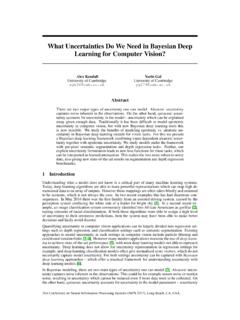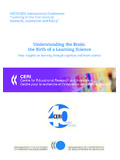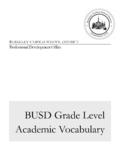Transcription of of Visual Features arXiv:1807.05520v2 [cs.CV] 18 Mar 2019
1 [ ] 18 Mar 2019. deep Clustering for Unsupervised Learning of Visual Features Mathilde Caron, Piotr Bojanowski, Armand Joulin, and Matthijs Douze Facebook AI Research Abstract. Clustering is a class of unsupervised learning methods that has been extensively applied and studied in computer vision. Little work has been done to adapt it to the end-to-end training of Visual Features on large scale datasets. In this work, we present DeepCluster, a clus- tering method that jointly learns the parameters of a neural network and the cluster assignments of the resulting Features . DeepCluster it- eratively groups the Features with a standard clustering algorithm, k- means, and uses the subsequent assignments as supervision to update the weights of the network.
2 We apply DeepCluster to the unsupervised training of convolutional neural networks on large datasets like ImageNet and YFCC100M. The resulting model outperforms the current state of the art by a significant margin on all the standard benchmarks. Keywords: unsupervised learning, clustering 1 Introduction Pre-trained convolutional neural networks, or convnets, have become the build- ing blocks in most computer vision applications [1,2,3,4]. They produce excellent general-purpose Features that can be used to improve the generalization of mod- els learned on a limited amount of data [5]. The existence of ImageNet [6], a large fully-supervised dataset, has been fueling advances in pre-training of con- vnets. However, Stock and Cisse [7] have recently presented empirical evidence that the performance of state-of-the-art classifiers on ImageNet is largely un- derestimated, and little error is left unresolved.
3 This explains in part why the performance has been saturating despite the numerous novel architectures pro- posed in recent years [2,8,9]. As a matter of fact, ImageNet is relatively small by today's standards; it only contains a million images that cover the specific domain of object classification. A natural way to move forward is to build a big- ger and more diverse dataset, potentially consisting of billions of images. This, in turn, would require a tremendous amount of manual annotations, despite the expert knowledge in crowdsourcing accumulated by the community over the years [10]. Replacing labels by raw metadata leads to biases in the Visual rep- resentations with unpredictable consequences [11]. This calls for methods that can be trained on internet-scale datasets with no supervision.
4 Unsupervised learning has been widely studied in the Machine Learning com- munity [12], and algorithms for clustering, dimensionality reduction or density 2 Mathilde Caron et al . Fig. 1: Illustration of the proposed method: we iteratively cluster deep Features and use the cluster assignments as pseudo-labels to learn the parameters of the convnet. estimation are regularly used in computer vision applications [13,14,15]. For example, the bag of Features model uses clustering on handcrafted local de- scriptors to produce good image-level Features [16]. A key reason for their success is that they can be applied on any specific domain or dataset, like satellite or medical images, or on images captured with a new modality, like depth, where annotations are not always available in quantity.
5 Several works have shown that it was possible to adapt unsupervised methods based on density estimation or di- mensionality reduction to deep models [17,18], leading to promising all-purpose Visual Features [19,20]. Despite the primeval success of clustering approaches in image classification, very few works [21,22] have been proposed to adapt them to the end-to-end training of convnets, and never at scale. An issue is that clustering methods have been primarily designed for linear models on top of fixed Features , and they scarcely work if the Features have to be learned simultaneously. For example, learning a convnet with k-means would lead to a trivial solution where the Features are zeroed, and the clusters are collapsed into a single entity.
6 In this work, we propose a novel clustering approach for the large scale end- to-end training of convnets. We show that it is possible to obtain useful general- purpose Visual Features with a clustering framework. Our approach, summarized in Figure 1, consists in alternating between clustering of the image descriptors and updating the weights of the convnet by predicting the cluster assignments. For simplicity, we focus our study on k-means, but other clustering approaches can be used, like Power Iteration Clustering (PIC) [23]. The overall pipeline is sufficiently close to the standard supervised training of a convnet to reuse many common tricks [24]. Unlike self-supervised methods [25,26,27], clustering has the advantage of requiring little domain knowledge and no specific signal from the inputs [28,29].
7 Despite its simplicity, our approach achieves significantly higher performance than previously published unsupervised methods on both ImageNet classification and transfer tasks. Finally, we probe the robustness of our framework by modifying the exper- imental protocol, in particular the training set and the convnet architecture. The resulting set of experiments extends the discussion initiated by Doersch et al . [25] on the impact of these choices on the performance of unsupervised meth- deep Clustering for Unsupervised Learning of Visual Features 3. ods. We demonstrate that our approach is robust to a change of architecture. Replacing an AlexNet by a VGG [30] significantly improves the quality of the Features and their subsequent transfer performance.
8 More importantly, we dis- cuss the use of ImageNet as a training set for unsupervised models. While it helps understanding the impact of the labels on the performance of a network, ImageNet has a particular image distribution inherited from its use for a fine- grained image classification challenge: it is composed of well-balanced classes and contains a wide variety of dog breeds for example. We consider, as an alternative, random Flickr images from the YFCC100M dataset of Thomee et al . [31]. We show that our approach maintains state-of-the-art performance when trained on this uncured data distribution. Finally, current benchmarks focus on the capa- bility of unsupervised convnets to capture class-level information.
9 We propose to also evaluate them on image retrieval benchmarks to measure their capability to capture instance-level information. In this paper, we make the following contributions: (i) a novel unsupervised method for the end-to-end learning of convnets that works with any standard clustering algorithm, like k-means, and requires minimal additional steps; (ii). state-of-the-art performance on many standard transfer tasks used in unsuper- vised learning; (iii) performance above the previous state of the art when trained on an uncured image distribution; (iv) a discussion about the current evaluation protocol in unsupervised feature learning. 2 Related Work Unsupervised learning of Features . Several approaches related to our work learn deep models with no supervision.
10 Coates and Ng [32] also use k-means to pre-train convnets, but learn each layer sequentially in a bottom-up fashion, while we do it in an end-to-end fashion. Other clustering losses [21,22,33,34] have been considered to jointly learn convnet Features and image clusters but they have never been tested on a scale to allow a thorough study on modern convnet architectures. Of particular interest, Yang et al . [21] iteratively learn convnet Features and clusters with a recurrent framework. Their model offers promising performance on small datasets but may be challenging to scale to the number of images required for convnets to be competitive. Closer to our work, Bojanowski and Joulin [19] learn Visual Features on a large dataset with a loss that attempts to preserve the information flowing through the network [35].


![arXiv:0706.3639v1 [cs.AI] 25 Jun 2007](/cache/preview/4/1/3/9/3/1/4/b/thumb-4139314b93ef86b7b4c2d05ebcc88e46.jpg)
![arXiv:1301.3781v3 [cs.CL] 7 Sep 2013](/cache/preview/4/d/5/0/4/3/4/0/thumb-4d504340120163c0bdf3f4678d8d217f.jpg)
![@google.com arXiv:1609.03499v2 [cs.SD] 19 Sep 2016](/cache/preview/c/3/4/9/4/6/9/b/thumb-c349469b499107d21e221f2ac908f8b2.jpg)






![arXiv:1702.08502v3 [cs.CV] 1 Jun 2018](/cache/preview/a/2/4/a/4/4/0/7/thumb-a24a44078e5c6dfc76865297435b0a13.jpg)


